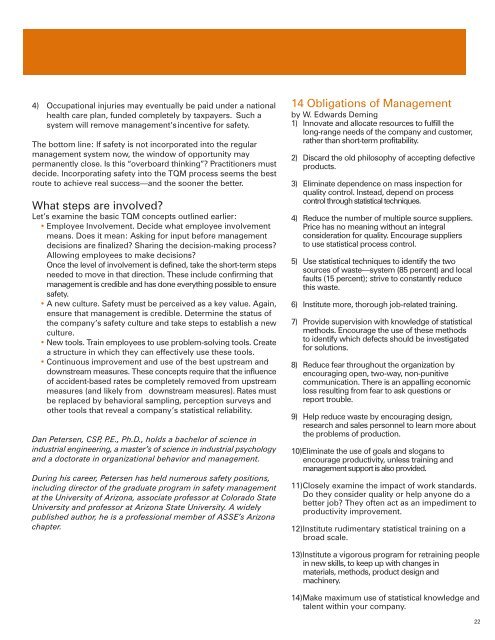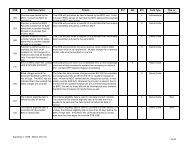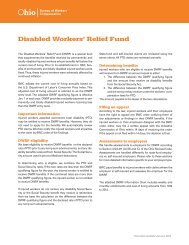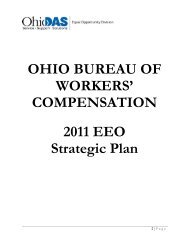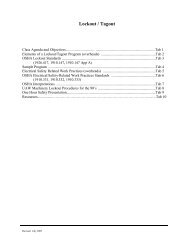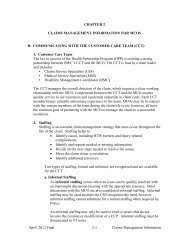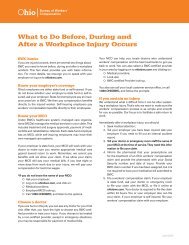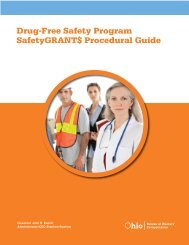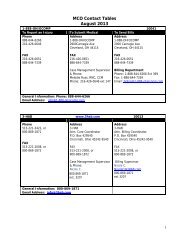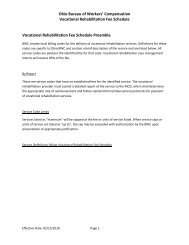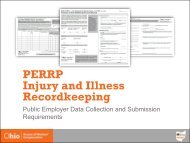BWC 10-Step Business Plan for Safety - Ohio Bureau of Workers ...
BWC 10-Step Business Plan for Safety - Ohio Bureau of Workers ...
BWC 10-Step Business Plan for Safety - Ohio Bureau of Workers ...
Create successful ePaper yourself
Turn your PDF publications into a flip-book with our unique Google optimized e-Paper software.
4) Occupational injuries may eventually be paid under a national<br />
health care plan, funded completely by taxpayers. Such a<br />
system will remove management’s incentive <strong>for</strong> safety.<br />
The bottom line: If safety is not incorporated into the regular<br />
management system now, the window <strong>of</strong> opportunity may<br />
permanently close. Is this “overboard thinking”? Practitioners must<br />
decide. Incorporating safety into the TQM process seems the best<br />
route to achieve real success—and the sooner the better.<br />
What steps are involved?<br />
Let’s examine the basic TQM concepts outlined earlier:<br />
• Employee Involvement. Decide what employee involvement<br />
means. Does it mean: Asking <strong>for</strong> input be<strong>for</strong>e management<br />
decisions are finalized? Sharing the decision-making process?<br />
Allowing employees to make decisions?<br />
Once the level <strong>of</strong> involvement is defined, take the short-term steps<br />
needed to move in that direction. These include confirming that<br />
management is credible and has done everything possible to ensure<br />
safety.<br />
• A new culture. <strong>Safety</strong> must be perceived as a key value. Again,<br />
ensure that management is credible. Determine the status <strong>of</strong><br />
the company’s safety culture and take steps to establish a new<br />
culture.<br />
• New tools. Train employees to use problem-solving tools. Create<br />
a structure in which they can effectively use these tools.<br />
• Continuous improvement and use <strong>of</strong> the best upstream and<br />
downstream measures. These concepts require that the influence<br />
<strong>of</strong> accident-based rates be completely removed from upstream<br />
measures (and likely from downstream measures). Rates must<br />
be replaced by behavioral sampling, perception surveys and<br />
other tools that reveal a company’s statistical reliability.<br />
Dan Petersen, CSP, P.E., Ph.D., holds a bachelor <strong>of</strong> science in<br />
industrial engineering, a master’s <strong>of</strong> science in industrial psychology<br />
and a doctorate in organizational behavior and management.<br />
During his career, Petersen has held numerous safety positions,<br />
including director <strong>of</strong> the graduate program in safety management<br />
at the University <strong>of</strong> Arizona, associate pr<strong>of</strong>essor at Colorado State<br />
University and pr<strong>of</strong>essor at Arizona State University. A widely<br />
published author, he is a pr<strong>of</strong>essional member <strong>of</strong> ASSE’s Arizona<br />
chapter.<br />
14 Obligations <strong>of</strong> Management<br />
by W. Edwards Deming<br />
1) Innovate and allocate resources to fulfill the<br />
long-range needs <strong>of</strong> the company and customer,<br />
rather than short-term pr<strong>of</strong>itability.<br />
2) Discard the old philosophy <strong>of</strong> accepting defective<br />
products.<br />
3) Eliminate dependence on mass inspection <strong>for</strong><br />
quality control. Instead, depend on process<br />
control through statistical techniques.<br />
4) Reduce the number <strong>of</strong> multiple source suppliers.<br />
Price has no meaning without an integral<br />
consideration <strong>for</strong> quality. Encourage suppliers<br />
to use statistical process control.<br />
5) Use statistical techniques to identify the two<br />
sources <strong>of</strong> waste—system (85 percent) and local<br />
faults (15 percent); strive to constantly reduce<br />
this waste.<br />
6) Institute more, thorough job-related training.<br />
7) Provide supervision with knowledge <strong>of</strong> statistical<br />
methods. Encourage the use <strong>of</strong> these methods<br />
to identify which defects should be investigated<br />
<strong>for</strong> solutions.<br />
8) Reduce fear throughout the organization by<br />
encouraging open, two-way, non-punitive<br />
communication. There is an appalling economic<br />
loss resulting from fear to ask questions or<br />
report trouble.<br />
9) Help reduce waste by encouraging design,<br />
research and sales personnel to learn more about<br />
the problems <strong>of</strong> production.<br />
<strong>10</strong>)Eliminate the use <strong>of</strong> goals and slogans to<br />
encourage productivity, unless training and<br />
management support is also provided.<br />
11)Closely examine the impact <strong>of</strong> work standards.<br />
Do they consider quality or help anyone do a<br />
better job? They <strong>of</strong>ten act as an impediment to<br />
productivity improvement.<br />
12)Institute rudimentary statistical training on a<br />
broad scale.<br />
13)Institute a vigorous program <strong>for</strong> retraining people<br />
in new skills, to keep up with changes in<br />
materials, methods, product design and<br />
machinery.<br />
14)Make maximum use <strong>of</strong> statistical knowledge and<br />
talent within your company.<br />
22


